#gond tribe lifestyle
Explore tagged Tumblr posts
Text
Gond: Tribal Art of the Heart of India
Gond art is a traditional form of painting that originated in Madhya Pradesh, India. It is mainly practiced by the Gond tribe living in that state. However, it can also be found in other states like Andhra Pradesh, Odisha, Maharashtra, and Chhattisgarh.
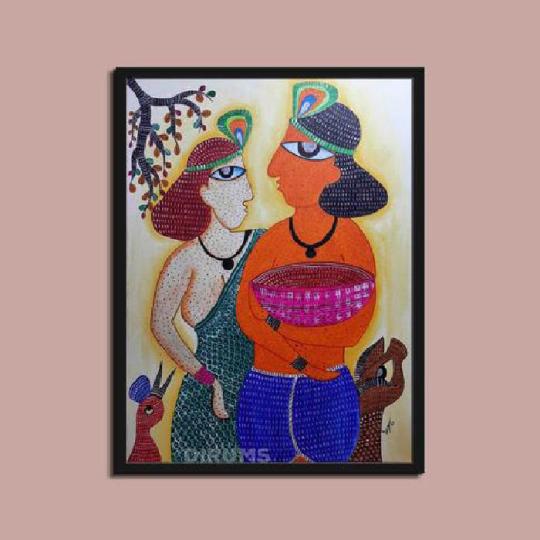
The Gonds are the largest tribal community in India, and their art is highly valued for its cultural heritage. Gond paintings showcase the tribe's lifestyle, their surroundings, and the wildlife in their area. These paintings also depict their beliefs, mythical creatures, and characters from their folklore, all of which are an essential part of their artwork. The Gond tribe believes that having good pictures around them brings good luck and positive energy. Animals play a significant role in their art, as the tribe believes that all beings are spiritual and sacred.
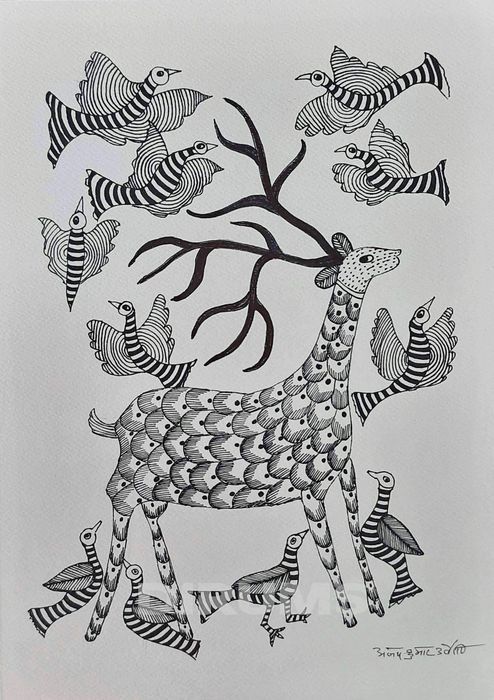
Gond paintings are filled with bright and lively colors like orange, yellow, blue, and red. They are created using carefully drawn lines and dots that bring the paintings to life. The artists use natural colors derived from sources like flowers, stones, and other materials to create these beautiful artworks.
The word “Gond” comes from the Dravidian expression kond, meaning “the green mountain.” The work of Gond artists is rooted in their folk tales and culture, and thus story-telling is a strong element of every painting.
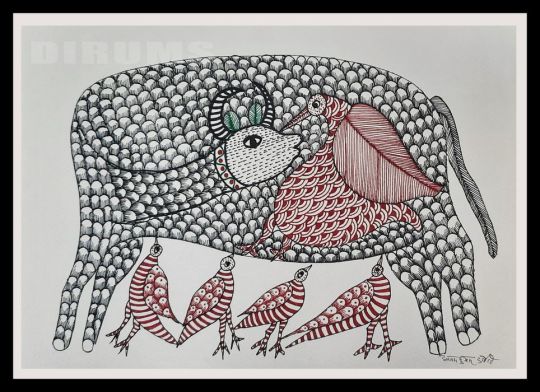
Gond art stems from the belief that a good image brings good fortune. This underlying belief has inspired the Gonds to decorate their homes and floors with traditional tattoos and motifs. Today, Gond art products such as Gond paintings on wood, painted wooden trays, and boxes have become extremely popular globally.
It is a matter of pleasure that Gond art has not escaped the eyes of art connoisseurs of the country. The Government of India is making efforts for the preservation of Gond painting. Other well-wishers went further and created Must Art Gallery – the world's first art gallery dedicated to Gond art. Unlike so many other treasures of Indian culture that have slipped through the cracks of time and are lost forever, the future of Gond art looks as vibrant and colourful as the paintings
----- END OF ARTICLE -----
#artwork#paintings#contemporary art#gondartwork#artgallery#artistsoninstagram#artistic#art on canvas#homedecor#artwork for sale
3 notes
·
View notes
Text
Experience the Authentic Odisha with Our Tribal Heritage Tours
Odisha is a land of diverse cultures, breathtaking landscapes, and ancient traditions. If you are an explorer seeking an offbeat travel experience, Tribal culture and heritage tours in Odisha offer a rare opportunity to immerse yourself in the vibrant lifestyle of indigenous communities.
At OD Travels, we curate immersive journeys that take you deep into the heart of Odisha’s tribal regions. From the colorful weekly markets of the Bonda and Dongria Kondh tribes to the mesmerizing dance performances of the Saura and Gond communities, every moment of this journey is a celebration of traditions passed down through generations.
Our guided tours ensure you witness the authentic essence of tribal life—be it through traditional art, music, handicrafts, or unique culinary experiences. Visit remote villages, interact with the locals, and gain insights into their eco-friendly way of living, untouched by modernity.
Beyond cultural experiences, these tours also take you through Odisha’s lush forests, majestic waterfalls, and serene landscapes, making it a perfect blend of adventure and heritage. Whether you're a history enthusiast, a nature lover, or a cultural explorer, our curated itineraries ensure a memorable experience.
Let OD Travels be your guide to exploring the rich tribal heritage of Odisha. Book your tour today and embark on an unforgettable journey into the soul of India's tribal heartland!
#TribalTourOdisha#OdishaCulture#ODTravels#TribalHeritage#IncredibleIndia#TribalLife#TravelOdisha#OffbeatTravel
0 notes
Text
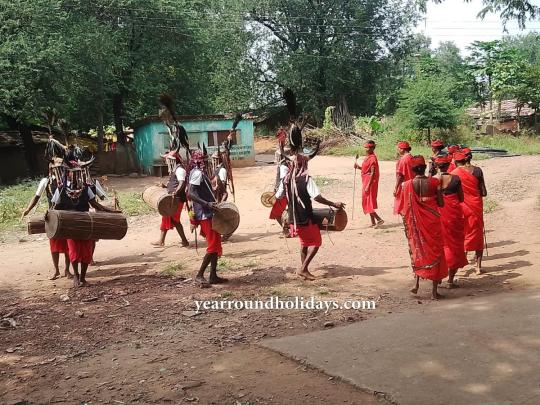
The Bison Horn Maria tribe, also known simply as the "Bison Tribe" or "Maria Tribe," is a notable indigenous community in central India, particularly in the Bastar region of Chhattisgarh. Here are some key aspects of the Bison Horn Maria tribe:
1. Origin and Location
The Bison Horn Maria tribe is primarily located in the dense forests and hilly terrains of Bastar, Chhattisgarh.
They are a subgroup of the larger Gond tribe, one of the largest indigenous communities in India.
2. Culture and Traditions
Dance and Costumes: They are famous for their Bison Horn dance, in which men wear headdresses resembling bison horns, made from buffalo horns, decorated with feathers and beads. This dance is a celebration of their warrior spirit and is often performed during festivals, marriages, and other cultural gatherings.
Music: The Bison Horn Maria tribe has a rich musical heritage that includes drums, flutes, and other traditional instruments that accompany their dances and ceremonies.
Art and Crafts: Their art includes intricate designs, especially in pottery, weaving, and body art, including tattoos.
3. Lifestyle and Economy
Agriculture: The tribe largely depends on subsistence farming, growing crops like rice, millets, and maize.
Hunting and Gathering: They supplement their diet and income through hunting, fishing, and gathering forest products like honey, herbs, and fruits.
Trade: They engage in barter and local trade to acquire items not available within their community.
4. Beliefs and Rituals
The Bison Horn Maria tribe follows animistic beliefs, worshipping natural elements, ancestors, and tribal deities.
Ghotul Tradition: A unique aspect of their culture is the “Ghotul,” a youth dormitory system where young tribe members learn social customs, tribal lore, and marriage practices. It serves as a social and cultural institution in the tribe.
5. Challenges
Like many indigenous communities, the Bison Horn Maria tribe faces issues related to land rights, displacement, and the impact of modern development projects.
Efforts are being made to preserve their culture and provide them with resources and rights to protect their traditional way of life.
Their vibrant culture and unique traditions make the Bison Horn Maria tribe a significant part of India’s tribal heritage.
0 notes
Text
SEPTEMBER OCTOBER IS THE BEST TIME TO VISIT KANHA NATIONAL PARK
Exploring the Wonders of Kanha National Park: A Perfect Visit in September and October
Introduction Kanha National Park, nestled in the heart of Madhya Pradesh, India, is one of the most celebrated wildlife sanctuaries in the country. Known for its lush landscapes, rich biodiversity, and being the inspiration for Rudyard Kipling’s The Jungle Book, it offers an unforgettable experience to nature lovers and wildlife enthusiasts. Among the best times to explore the magic of this national park is during September and October, right at the cusp of the monsoon retreating and autumn setting in. This blog will walk you through what makes these months ideal for a visit, the experiences awaiting you, and travel tips to make your trip truly remarkable.
Why Visit Kanha National Park in September and October?
1. Pleasant Weather
The rainy season ends in August, leaving behind a refreshing green landscape. With the air feeling cool and crisp, temperatures in September and October typically range between 20°C to 30°C (68°F to 86°F). It’s the perfect time to roam around comfortably without the sweltering heat of summer or the cold of winter.
2. Lush Greenery Post-Monsoon
The monsoon rejuvenates the park, turning the forest into a paradise of emerald foliage. The streams and water bodies are replenished, adding charm to the surroundings. This greenery not only enhances the park’s beauty but also improves your chances of spotting wildlife, as animals gather near water sources.
3. Improved Wildlife Sightings
Although the lush vegetation can sometimes make spotting animals a bit tricky, the abundance of water draws animals out into the open. In these months, you can encounter a variety of creatures such as the Royal Bengal Tiger, Indian Gaur (Bison), leopards, barasingha (swamp deer), and a plethora of bird species.
4. Birdwatcher’s Delight
The transition from the monsoon to winter marks the beginning of birdwatching season. Kanha becomes home to both resident and migratory birds. You can spot birds like the Indian roller, Ma pied hornbill, and several species of eagles and vultures.labar
5. Less Crowded Than Peak Season
While Kanha draws visitors year-round, September and October remain relatively less crowded compared to the peak winter months of November to February. This gives you a more serene experience of the wilderness without the typical tourist rush.
Top Activities to Experience in Kanha
1. Jungle Safari
A jungle safari is a must to explore the deep interiors of the forest. Kanha offers both morning and evening safari rides, allowing you to enjoy wildlife at different times of the day. Jeep safaris are the most popular option, but elephant-back rides are also available for a unique perspective.
Morning Safari Timings: 6:30 AM – 10:30 AM
Evening Safari Timings: 3:00 PM – 6:00 PM
Make sure to book your safari in advance as slots fill up quickly, even in less crowded months.
2. Nature Walks and Birdwatching
If you are an avid birder or prefer a more immersive experience, a guided nature walk is the perfect way to explore the park. With binoculars in hand, you can observe the park’s avian diversity up close.
3. Bamni Dadar – Sunset Point
Known as the sunset point of Kanha, Bamni Dadar offers breathtaking views of the forest bathed in golden hues during sunset. Many herbivores like sambars and gaur can also be spotted in the open grasslands here, making it a scenic spot for photography.
4. Tribal Museum Visit
In addition to wildlife, Kanha offers insights into the local tribal culture. The park is home to the Gond and Baiga tribes, and a visit to the Tribal Museum near the park gate will introduce you to their art, culture, and traditional lifestyle.
Key Wildlife in Kanha
Royal Bengal Tiger: One of the park’s major attractions and the most sought-after species by visitors.
Barasingha (Swamp Deer): Known as the “Jewel of Kanha,” the barasingha is endemic to the park and has been successfully conserved here.
Leopards and Sloth Bears: While more elusive, these creatures offer a thrilling sight when encountered.
Indian Gaur (Bison): The world’s largest wild cattle species, often seen grazing in meadows.
Birdlife: Keep an eye out for kingfishers, serpent eagles, storks, and hornbills during your safaris.
Travel Tips for Visiting Kanha in September and October
Book Safaris and Accommodation in Advance: Although these months are not peak season, planning early ensures you secure the best safari slots and lodging.
What to Wear: Light cotton clothes work well during the day, but carry a light jacket or sweater for early mornings and evenings when it can get chilly.
Carry Binoculars and a Camera: These will enhance your wildlife viewing experience. A DSLR with a good zoom lens is ideal for photography enthusiasts.
Respect Park Rules: Always follow the park’s guidelines to ensure your safety and that of the wildlife. Avoid littering or disturbing animals.
Stay Hydrated and Pack Snacks: While the weather is pleasant, staying hydrated is crucial during safaris. Some snacks can also help keep your energy levels up.
Where to Stay in Kanha
Kanha offers a range of accommodations to suit different budgets and preferences. Some of the popular options include:
Luxury Resorts: Taj Safari Lodge, Kanha Jungle Camp
Mid-Range Hotels: MPT Jungle Resort, Sterling Kanha
Budget-Friendly Options: Kanha Earth Lodge, tribal homestays
Most resorts and lodges are located near the park’s Kisli and Mukki gates. Staying near these entry points makes it easier to access the park for early morning safaris.
How to Reach Kanha National Park
By Air
The nearest airport is in Jabalpur (approximately 170 km away). Other nearby airports include Nagpur (270 km) and Raipur (220 km). From the airport, you can hire a taxi or take a bus to reach the park.
By Train
The closest railway stations are Jabalpur, Gondia, and Bilaspur. Trains from major cities like Delhi, Mumbai, and Kolkata connect to these stations.
By Road
Kanha is well-connected by road to nearby cities like Jabalpur, Nagpur, and Raipur. Regular buses and private taxis are available, making road travel a convenient option.
Conclusion
A trip to Kanha National Park in September and October promises a blend of tranquility, adventure, and natural beauty. Whether you are hoping to spot the elusive tiger, witness the unique barasingha, or simply soak in the serenity of the forest, this park offers it all. The pleasant weather, lush greenery, and relatively low crowds make it an ideal time to visit. With proper planning and a sense of adventure, your journey to Kanha will surely be one to remember.
Pack your bags, book your safari, and get ready to explore the enchanting wilderness of Kanha!
Thank for Read may blog - view more
1 note
·
View note
Text
Things to do in Tadoba Andhari Tiger Reserve
Tadoba Andhari Tiger Reserve is situated in the district of Chandrapur in the state Maharashtra of India which is famous wildlife spot of tigers and the asylum of biological diversification. If you're planning a trip, here are some exciting things to do:
Top Things to do in Tadoba
1. Jungle Safari
Experience the Thrill of Wildlife: Tiger spotting is especially loved by tourists in Tadoba. Choose jeep safari or canter safari an open bus which covers the core as well as the buffer areas of the park.
Best Zones for Safari: KDD is divided into zone-wise six tourism zones out of which Moharli, Kolsa and Tadoba are well-known for sighting wild animals. There are transitory appearances of tigers regularly at Moharli zone.
Animals to Spot: In addition to the tigers, you can expect to see leopards, sloth bears, wild dogs (Dholes), Gaur (Indian Bison), Sambar deer, spotted deer and many birds.
2. Nature trail and Bird watching
Enjoy Nature's Serenity: There is more to see at Tadoba National Park than just tigers and other big cats. This park contains over 195 bird species and varieties such as water birds, eagles, owls and migratory birds.
Bird Watching: A nature trail/ bird watching trip around the lake and bamboos forests provides the visitor with an excellent view of the birds in the park.
3. Visit Tadoba Lake
Scenic Beauty: Tadoba lake located inside the core area is an excellent point for relaxation and to have a close look at the wild life.
Photography: This area is perfect for photography as the animals will come out in their natural instinct during sunrise and in the evening. Tigers, crocodiles and birds can be seen in and around the lake region.
4. Stay at Jungle Resorts
Experience Wilderness: Some of the common jungle resorts near this reserve are many and there are many eco-lodges located in this reserve where one can comfortably sleep. These can be simple cabins with a log cabin feeling but with every conceivable luxury.
Night Safaris and Campfires: They can as well organize for night viewing in the buffer areas so that one can be able to view the wild at night too.
5. Visit Local Villages
Cultural Experience: This project should try to involve the local tribal population such as the Gond and Kolam tribes. Find out more about their customs, beliefs and a daily lifestyle associated with the forest.
Handicrafts and Souvenirs: Shop for local artifacts, especially crafted by the tribes.
6. Photography Tours
Wildlife Photography: The photo safari in particular is great at Tadoba. That way, regardless of whether you are a professional or just an occasional tourist, there could hardly be a better place to visit as the wildlife here teems with terrific tigers and colorful birds besides breathtaking vies of sceneries.
Best Time for Photography: There is nothing as beautiful as taking a photography session at the break of dawn and at the dusk.
7. Ancient Tadoba Temple
Said to have been build around the 7th century, this temple, built in honour of Tadoba, an associated deity of the region is located on the periphery of Tadoba Lake and can be explored with respect to spirituality and traditions.
8. Explore the Buffer Zone
The places like Agarzari and Devada are comparatively less crowded as compared to areas near the park and the authorities also encourage wildlife tourism and you can spot lion, tiger, leopard etc.
9. Boating and Lake Safari tour at Irai Lake
Peaceful Boating: About 30 Kms from Tadoba there is a beautiful place Irai Lake to enjoy boating amidst natural surrounding. You can pass a time here and watch other animals being drawn to come to water for water.
Wildlife Viewing: Wildlife while at the lake safari may be occasioned to see crocodiles, birds and occasionally other wild creatures along the shores of the lake.
10. Explore Tadoba Museum
There is an information centre present at the Entry gate of the museum, which provides information regarding the park, the wildlife, the forest found in the region and the measures taken to preserve wildlife.
Travel Tips for Tadoba:
Best Time to Visit: October to March is perfect for Wildlife watching and good climate prevails.
Booking in Advance: Buy safari tickets through online booking to avoid the crowd.
Carry Essentials: Apart from the essential items, while going on a safari, you should always carry sunglasses, hat, binoculars, camera, bottle and water with you.
Tadoba Andhari Tiger Reserve offers a wonderful opportunity to observe jungle and wildlife, nature and history, wildlife and culture.
#travel#tour#india#india travel#tadoba#tadoba national park#tadoba tiger reserve#tadoba reserve#india tour#india tourism
0 notes
Text
Mapping the Tribes of India: Where, Safety, and Cultural Richness
India, a land of immense diversity, is home to a vast array of cultures, languages, and traditions. Among its most intriguing aspects are the numerous tribes of India, each with its unique way of life, customs, and history. From the remote hills of the Northeast to the dense forests of Central India, these tribes offer a fascinating glimpse into the country’s rich cultural mosaic. This blog delves into where these tribes can be found, how to visit them safely, and what makes their cultures so captivating. Let’s explore all about Indian tribes and their vibrant heritage.
Understanding the Tribes of India
The tribes of India are indigenous communities that have preserved their ancient cultures and traditions despite the march of modernity. There are over 700 recognized tribes in India, each with distinct languages, lifestyles, and practices. They can be broadly categorized based on their geographical locations: the Northeast, Central India, Southern India, and the Andaman and Nicobar Islands. Understanding the diversity and distribution of these tribes is essential to appreciate their contribution to India’s cultural tapestry.
Northeast India: A Melting Pot of Cultures
The Northeast region of India is a treasure trove of tribal cultures. States like Arunachal Pradesh, Nagaland, Manipur, and Mizoram are home to numerous tribes, each with its unique traditions.
1. The Apatani Tribe of Arunachal Pradesh
The Apatani tribe is known for their sustainable agricultural practices and intricate facial tattoos. Their village, Ziro, is a UNESCO World Heritage site and provides a fascinating insight into their way of life.
2. The Konyak Tribe of Nagaland
The Konyak tribe, famous for their headhunting history, now live peacefully while maintaining their rich cultural heritage. Their elaborate tribal attire and traditional dances are a sight to behold.
3. The Zeliangrong Tribe of Manipur
The Zeliangrong tribe is renowned for their colorful festivals and deep spiritual practices. The community celebrates various festivals, such as the Gaan Ngai, which reflects their rich cultural heritage.
Central India: The Heartland of Tribal Culture
Central India is home to some of the most prominent tribes of India, including the Gond, Baiga, and Bhil tribes. This region’s dense forests and rugged terrains have allowed these tribes to preserve their ancient ways of life.
1. The Gond Tribe
The Gonds, one of the largest tribes in India, are primarily found in Madhya Pradesh, Chhattisgarh, and Maharashtra. They are known for their vibrant art forms, including the famous Gond paintings, which depict their folklore and nature.
2. The Baiga Tribe
The Baiga tribe, residing in the forests of Madhya Pradesh and Chhattisgarh, are known for their deep connection with nature and their shamanistic practices. They are often referred to as the ‘Kings of the Forest.’
3. The Bhil Tribe
The Bhil tribe, spread across Rajasthan, Gujarat, Madhya Pradesh, and Maharashtra, are known for their archery skills and vibrant festivals. Their traditional dance forms and folklore are integral parts of their cultural identity.
Southern India: A Blend of Tradition and Modernity
Southern India is home to numerous tribes that have seamlessly blended tradition with modernity. The Nilgiri hills, Western Ghats, and other forested regions are inhabited by various tribes of India.
1. The Toda Tribe
The Todas of the Nilgiri Hills in Tamil Nadu are known for their unique barrel-shaped huts and exquisite embroidery. Their pastoral lifestyle and dairy-based economy are fascinating aspects of their culture.
2. The Kurumba Tribe
The Kurumbas, also residing in the Nilgiri Hills, are known for their skills in herbal medicine and basket weaving. Their intimate knowledge of the forest and its resources is impressive.
3. The Chenchu Tribe
The Chenchus, living in the forests of Andhra Pradesh and Telangana, are primarily hunter-gatherers. Their simple lifestyle and deep knowledge of the forest ecology are noteworthy.
Andaman and Nicobar Islands: Preserving Ancient Ways
The Andaman and Nicobar Islands are home to some of the most isolated tribes of India, such as the Jarwa, Onge, and Sentinelese. These tribes have lived in isolation for thousands of years, maintaining their unique lifestyles and resisting outside influences.
1. The Jarwa Tribe
The Jarwas, inhabiting the dense forests of the Andaman Islands, have had limited contact with the outside world. They are known for their hunting and gathering lifestyle and their deep connection with nature.
2. The Onge Tribe
The Onges, residing in the Little Andaman Island, have a semi-nomadic lifestyle. Their traditional practices and knowledge of the island’s ecosystem are integral to their survival.
3. The Sentinelese Tribe
The Sentinelese, one of the most isolated tribes of India, live on North Sentinel Island. They have resisted contact with outsiders, preserving their way of life for thousands of years.
Safety and Respect When Visiting Tribal Areas
Exploring all about Indian tribes requires a respectful and sensitive approach. These communities have preserved their cultures through centuries, often resisting modern influences to maintain their traditional ways. Here are some guidelines for safely and respectfully visiting tribal areas:
1. Research and Respect
Before visiting any tribal area, do thorough research about the community’s customs and traditions. Respect their way of life and seek permission before taking photographs or engaging in their activities.
2. Use Local Guides
Hiring local guides who are familiar with the tribal communities can enhance your experience. They can provide valuable insights into the culture and help you navigate through the area respectfully.
3. Follow Ethical Tourism Practices
Ensure that your visit benefits the community. Purchase local crafts, support tribal businesses, and avoid any activities that might exploit or harm the community.
4. Health and Safety Precautions
Tribal areas might lack modern medical facilities. Carry a basic first aid kit, necessary medications, and ensure you are vaccinated against common diseases prevalent in the area.
5. Environmental Responsibility
Tribal communities often live in harmony with nature. Ensure that your visit does not disrupt their environment. Avoid littering, respect wildlife, and minimize your ecological footprint.
Embracing the Richness of Indian Tribes
Learning all about Indian tribes offers a deeper understanding of the country’s rich and diverse cultural fabric. The tribes of India, with their unique traditions, art forms, and lifestyles, contribute significantly to the nation’s heritage. By exploring these communities with respect and sensitivity, we can gain valuable insights into their way of life and ensure that their cultures continue to thrive in the modern world.
From the vibrant festivals of the Northeast to the intricate art forms of Central India, and the isolated tribes of the Andaman and Nicobar Islands, the tribes of India present a kaleidoscope of cultures waiting to be explored. By mapping the tribes of India, we not only celebrate their diversity but also acknowledge the vital role they play in enriching the nation’s cultural landscape.
As we venture into 2024, let us embark on a journey to discover and appreciate all about Indian tribes, ensuring that our interactions are respectful and beneficial to these incredible communities. The tribes of India are not just a part of the past; they are a living testament to the enduring spirit of human diversity and resilience.
0 notes
Text
Discover the Unique Tribes of Madhya Pradesh: Culture, Traditions, and Heritage
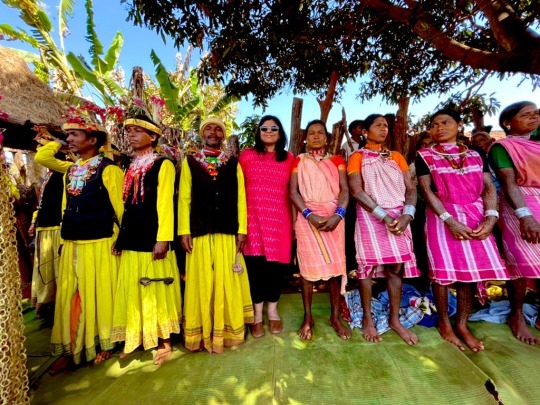
Discover the vibrant heritage of the Tribes of Madhya Pradesh. Explore the rich culture, traditions, and festivals of the Gond, Bhil, and Baiga communities. Uncover their unique art, music, and lifestyle in the heart of India. Perfect for cultural enthusiasts and history buffs.
0 notes
Photo
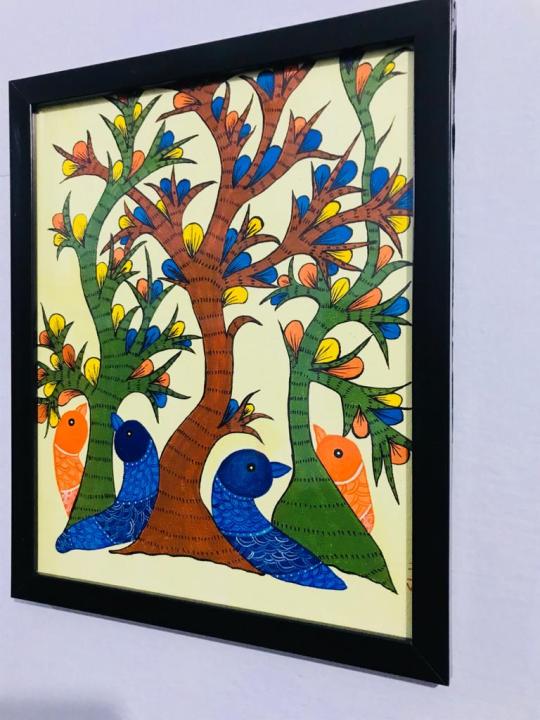
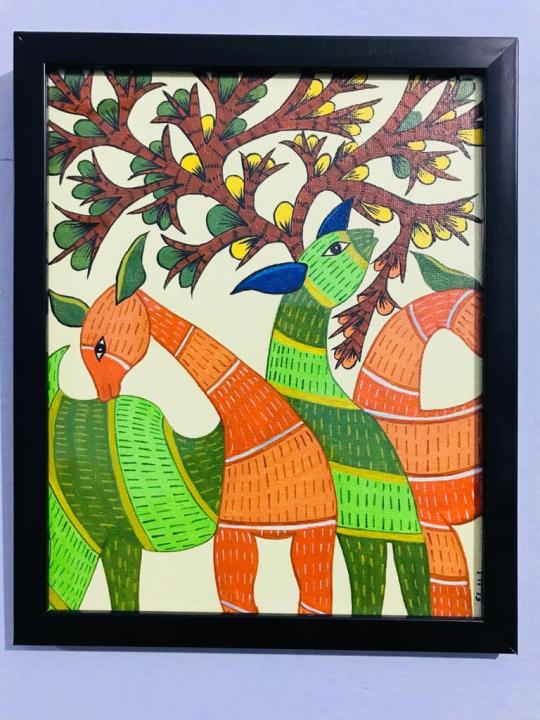
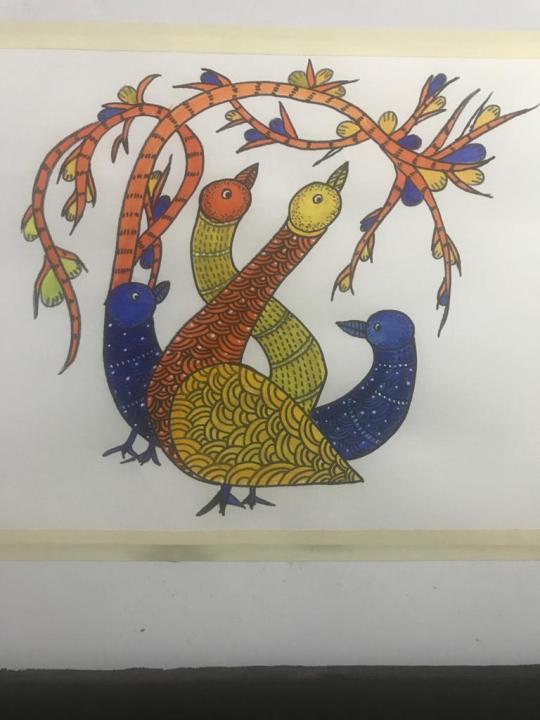
Gond Art paintings
Gond painting price, information, tutorial, images, history and gond art techniques
Today's Gond paintings have become quite popular because of the efforts by the Govt of India to promote and showcase the beauty of tribal art.There have been expo of Gond paintings in many region of the world . Gond paintings price between Rs 3000/- to Rs 50000/-
Today , many talented Gond artists works including Shubhi Jain can be seen on canvases in art galleries internationally.
Shubhi Jain mainly preferred the tree of life surrounded by deer figures .She features different kinds of birds too , while her signature pattern is tree almost erect and still . She takes 3 -21 days to make each painting.
In the eyes of a Gond artist , everything is sanctified and intimately connected to nature . Thus ,the unique oral narrative tradition of the Gond art is reflected in their paintings as well The work of Gond artists is rooted in their culture , and thus story - telling is a strong element of every painting .
However every artist today has a personal style and has developed a specific language within these narratives creating a richness of artfully forms and styles.
Who are Gond Tribes ?
Gond are one of the largest tribes in india and are Dravidian's whose origin can be traced to the pre -Aryan era , who are mainly from Madhya Pradesh and also found in some place of Andhra Pradesh , Maharashtra , Chhattisgarh and Odisha
The word gond comes from kond which means green mountains in the Dravidian idiom. About half of Gonds speak Gondi Languages , While the rest speak Indo - Aryan languages including hindi.
The Gond are also knowns as the Raj Gond The term was widely used in 1950s , but has now become almost obsolete , probably because of the political eclipse of the Gond Rajas. The Gondi language is closely related to Telugu , belonging to the Dravidian family of languages.
The recorded history of the Gond people goes back 1400 years , but considering that they inhabit areas where rock paintings dating to the Mesolithic have been found , their antecedents probably date back even further .
Many of the Gonds customs echo that of their Mesolithic for bearers .An obvious example of this is the custom of embellishing the walls of their houses , an activity that may originate in cave - habitation tradition of their forefathers.
What are the main festivals of Gonds ?
The Gonds paint their walls on festive juncture such as karva Chauth , Diwali , Ashtami , and Nag Panchmi , Gond painting delineate various celebrations ,rituals and man's connection with nature . The artists use natural colors extract from charcoal , colored soil , plant sap , leaves and cow dung .
How is Gond art made ?
Gond paintings can be best be described as 'on line work'. The creator makes sure to draw the inner as well as outer lines with as much care as possible so that the perfection of the lines has an immediate effect on the viewer .
Lines are used in such a way that it conveys a sense of movement to the still images . Dots and dashes are added to impart a greater sense of movement and increase the amount of detail.
In current scenario gond paintings aren't painted on walls and floors and are instead painted on canvas. easy to transport , carry and hang on a wall .
Due to paucity of natural colors in the current age , Gond artists have started to use poster colors .This combined with the use of canvas has made modern Gond paintings much more chromatic than its traditional counter parts.
Gond Art technique tips by artist 'Shubhi Jain'
" Hello art lovers first draw a rough pencil sketch then draw a black outline with use of bright flamboyant colors and with the help of lines, dots and dashes try to create a pattern of design of your own"
" Conventionally , the Gond paintings were done on mud walls with colors elicited from natural materials like soil , charcoal , cow dung and leaves "
" Most important Gond paintings as ' on line work '. Art is created out of carefully draw lines. Lines are used in such a way to convey a sense of movement to still images"
Quote by Gond artist 'Shubhi Jain'
" A painting shows a journey of artist without words"
This blog exclusively sponsored by ' THE NEON ART ACADEMY '
#gondart#gond painting#gond tribe lifestyle#gond art tree#gond art deer#gond art peacock#gond art birds#artsy#ArtGallery#artists on tumblr#ArtMuseum#painting#painter legend
0 notes
Text
Why Odisha Chhattisgarh Tribal Tour Becoming More Popular in India
Odisha, the state in the eastern part of India, is a very popular destination among tourists.
Best tour packages of Odisha contain serene beaches, beautiful forests and coloured ethnic tribes. The South Western part of Odisha contains the largest concentration of Tribal people in the Sub-continent.It has 62 notified tribes, 9 are declared as primitive by Govt. Till date they follow the life style which is very interesting to watch. Anybody interested for a best Tribal Tour Package to witness the innocence of tribes and their lifestyle residing in different parts of Odisha can contact Swosti Travels. Carefully designed tribal tour packages encompasses tribes like Bonda, Kutia Kondh, Desia Kondha, Paraja,Saura etc. The weekly market of different tribes is very colourful, the arms they use are very primitive, the jewellery the tribal ladies wear is also amazing.
A very pronominal tribe of Odisha
Dangaria Kondh worship the mountain God. This kind of tribes make tattoo of on their face and body. Dangaria women wear many rings through their ear & three nose rings. A recent study has given one statistics that Dangaria gather almost 200 different foods from their forests & harvest over 100 crops from their field.They still follow the sacrifice process before new plantation & after each harvest.
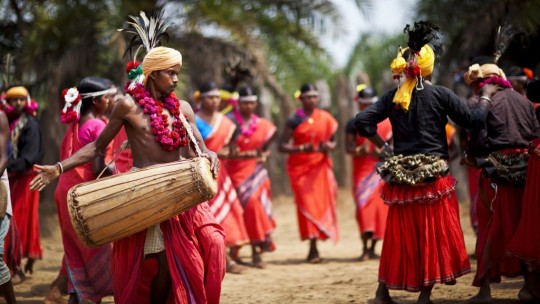
The Saura tribes are called by various names such as Sabar/Sora. The Saura villages are situated in the most in-accessible areas and in many cases lie hidden in forest. The Saura women wear waist cloth which hardly reaches their knee. The Saura tribes are very famous for their wall paintings called “IKONS” which are of religious significance.
Another very primitive tribe is Bondos. These tribes are very rude and ruthless. They are very scantily dressed, womens are with their clean shaven head decorated with headband. Ornaments of this tribe is very bright and attractive which a tourist can see in their tribal tour package.
Gadaba is another very prominal tribe of Odisha whose dance form “Dhemsa” where women perform dance and men folk play their musical instruments. In this type of tribe all the unmarried men sleep in one place and all unmarried girls they also sleep together in another place.
Paraja is another major tribe of Odisha and this is again divided into two broad section that is Bada Paraja and Sana Paraja. These tribes wear brass made jewellery. They grow variety of cereals, pulses and vegetables. Use of liquor is customary in all rituals of this tribes.
Apart from above, tribal dance is very popular among tourists. After day’s tour to different tribal rich areas one can enjoy the tribal dance in the evening where both ladies and gents participate and dance with the rhythm of local drums.
Swosti Travels can organise Tribal tours both for FITs and groups in a very affordable price. Swosti Travels has also successfully handled tour for many research scholars where they stay more than a month to have indepth idea about tribal life style.Apart from Tribal Tour to Odisha, Swosti Travels can also organize Odisha Chhattisgarh Tribal Tour.In Odisha Chhattisgarh Tribal Tour one can see the unique superstitious and a very traditional life style of tribes like Maria,Muria,Gonds and Dhuruva in Chhattisgarh.
The Maria tribes is one amongst the five ancient tribes of Chhattisgarh.This tribe lives in isolated place, mostly in the district of Bastar. They worship mother Earth. Tribes of Chhattisgarh mainly use small head necklaces which are mostly of beads,clay and metals.
Govt. of both Odisha & Chhattisgarh is now putting in efforts to educate them to have a better or healthier life.
As per guests requirement Swosti Travels can also make customized Itinerary. For more details one can contact by email: [email protected] or visit our web site www.swostiindia.com
We are Specialist in Beach Tours, Tribal Tours, Heritage & Cultural Tours, Adventure & Wildlife Tours, Monuments & Temples Tours, Buddhist Tours, Textile & Handicraft Tours, Special Interest Tours, Medical Value Tours, Spiritual Tours, Eco Tours, MICE & Hotel Reservations.
Swosti Travels & Exports, 103, Janpath Rd, Master Canteen Area, Kharabela Nagar, Bhubaneswar, Odisha 7510011 Mob : 9338091727 / 9337209141 Email: [email protected]
Authorized agent of IRCTC with ISO 9001:2008 certified & IATA accredited and Member.
100% Secure Payments All major credit & debit cards accepted
Follow Us: Facebook, Twitter, Linkedin /Swostitravel
1 note
·
View note
Text
Uncover Odisha's Unique Traditions with OD Travels’ Tribal Culture and Heritage Tours
Odisha, a vibrant state in India, is celebrated for its unparalleled tribal heritage and cultural diversity. With OD Travels’ exclusive Tribal culture and heritage tours in Odisha, you can immerse yourself in the traditions, customs, and lifestyles of Odisha’s indigenous tribes, who have preserved their unique identities for centuries.
These thoughtfully designed tours take you deep into remote tribal villages, where you can witness ancient rituals, captivating art forms, traditional dances, and exquisite craftsmanship. Tribes like the Saoras, Kondhs, and Gonds showcase a harmonious way of life, deeply connected to nature and their cultural roots. With OD Travels, you’ll explore their heritage in an authentic and meaningful way.

From the picturesque hills of Koraput to the serene forests of Malkangiri, OD Travels offers a diverse range of destinations for a comprehensive experience. Highlights of our Tribal culture and heritage tours in Odisha include:
Visits to tribal museums that provide fascinating insights into their history.
Hands-on interactions with local artisans practicing traditional crafts such as weaving, pottery, and painting.
Scenic nature walks through Odisha’s breathtaking landscapes, featuring waterfalls, dense forests, and vibrant flora and fauna.
Whether you're a photography enthusiast, a cultural explorer, or a curious traveler, our tours cater to your interests. Led by experienced guides well-versed in the region’s tribal history, every moment of your journey promises to be safe, enriching, and unforgettable.
For those seeking an even deeper connection, our tours include opportunities to participate in tribal festivals and community celebrations. Experience the vibrant spiritual practices, lively dances, and unique ceremonies that embody the soul of Odisha’s tribal communities.
Embark on a transformative journey with OD Travels. Our Tribal culture and heritage tours in Odisha offer an extraordinary blend of adventure, cultural education, and natural beauty. Let us take you to the heart of Odisha’s tribal heritage, where every moment is a celebration of life and culture.
Book your tour today and uncover the incredible stories waiting to be discovered in Odisha’s tribal heartland!
#travelwithodtravels#explorebhubaneswar#travelindia#exploreodisha#bhubaneswartour#odishatourism#templecity#odtravels#bhubaneswar#chilikalake
0 notes
Text
What are the origins of Gond Art?
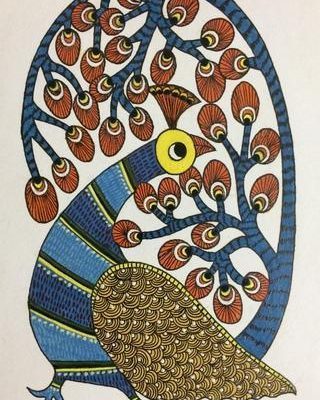
Gond Art is a folk tribal art form practiced by arguably the largest tribe in Central India. The art form today is expanding many new horizons and has acquired a cult following in Indian art connoisseurs. The tribes involved in this art form predominantly hail from Madhya Pradesh and parts of Chattisgarh, Odisha, Andhra, Telangana Maharashtra. Although we mainly associate it with these pockets this art form with time has acquired a pan-Indian appeal and enhances the rich heritage India takes pride in. Let us discuss how this rich tradition grew. From where it all started The recorded history of Gond Art goes back to as many as 1400 years. The areas where we find its traces have also been identified with rock paintings from the Mesolithic age. Since there is a very evident stylistic and thematic influence of Mesolithic paintings in Gond Art, who knows probably their legacy dates back even further? The Gonds trace their roots back to the Pre-Aryan age and anthropological sources identify them as Dravidians. The dialect they speak is also heavily influenced by Telegu and other Dravidian languages. Why Gond? The word Gond comes from Kond in the Dravidian idiom which means green mountains No wonder why nature is such an integral thematic stylistic element in Gond Art with the recurrent depiction of motifs like trees, leaves, animals, birds, fishes, fish scales, drops of water and primitive human figurines. Gond Art's existence is so much intertwined with nature that paintings for them are an offering to the worship of nature and a divine medium for seeking protection and warding off evil. Values beliefs: The Koi or Koiture what the Gonds call themselves, traditionally hold the belief that a good image begets good luck. This explains why Gond Art for the Kois wasn't just a recreational pastime but a part of their lifestyle. They decorated the walls and floors of their houses with traditional motifs and tattoos. The paintings were influenced by Mahari Devi, Phalvari Devi (Goddess Kali), local flora fauna and were made on festive occasions like Karwa Chauth, Ashtami Nag Panchami. Colors painting style: The Gond painting uses bright vivid colors like yellow, red, blue, and white. These days due to the paucity of natural colors the Gond paintings we see are made by poster colors on the canvas, however, traditionally the colors were derived from charcoal, colored soil, plant sap, mud, flowers, leaves, and cow dung. The extensive use of straight lines that we see in Gond Art is used to convey a sense of movement and add motion to the still paintings. The use of dots dashes enhances the illusion of motion and increases the scope for depicting things in detail. Gond Art in form and the range of subjects it derives its art out of celebrates the rich heritage of India. It is important that we promote it and reinvent it in our aesthetic choices and preferences. Artists like Suresh Kumar Dhurve, Kalam Patua, and Balua Devi through their paintings are taking this art form to a global platform. We have gained enough that the world has had to offer us, it's high time that we now look within our rich and vibrant cultural heritage. Penkraft conducts classes, course, online courses, live courses, workshops, teachers' training & online teachers' training in Handwriting Improvement, Calligraphy, Abacus Maths, Vedic Maths, Phonics and various Craft & Artforms - Madhubani, Mandala, Warli, Gond, Lippan Art, Kalighat, Kalamkari, Pichwai, Cheriyal, Kerala Mural, Pattachitra, Tanjore Painting, One Stroke Painting, Decoupage, Image Transfer, Resin Art, Fluid Art, Alcohol Ink Art, Pop Art, Knife Painting, Scandinavian Art, Water Colors, Coffee Painting, Pencil Shading, Resin Art Advanced etc. at pan-India locations. With our mission to inspire, educate, empower & uplift people through our endeavours, we have trained & operationally supported (and continue to support) 1500+ home-makers to become Penkraft Certified Teachers? in various disciplines.
1 note
·
View note
Text
What is the theme of Gond art?
What is Gond art? Gond art is a form of tribal art originating in India, largely practised by the Gond tribe. It is a colourful style of painting often depicting animals, plants, and nature, as well as religious and folkloric themes. Gond art is characterized by its bold, geometric lines and vibrant use of colour, and is often painted on walls, fabrics, and other surfaces.
Importance of Gond art
Gond art is one of the important parts of India’s cultural heritage and has become increasingly popular in recent years. It is a unique form of expression that reflects the lifestyle and beliefs of the Gond people, as well as their deep connection to nature. The Gond art is also used to promote environmental protection, biodiversity, and cultural awareness. Gond art has also become an important source of income for the Gond artists, providing the communities with a chance to express their art.

Use of Gond art
Gond art is often used to decorate walls, fabrics, and other surfaces. It has also been used in advertising, book illustrations, and even in the design of textiles and jewellery. In recent years, Gond art has been used in the design of furniture and home decor, including rugs, cushions, and lamps. It has also been used to create unique, beautiful pieces of art that can be hung in homes and offices.
The theme of Gond art
Gond art usually depicts animals, plants, and nature, as well as religious and folkloric themes. Patterns like lines, dashes, and dots are used in the art filled with vivid colours. Common themes in Gond art include trees, flowers, birds, and animals, as well as Hindu gods and goddesses. Other common themes include stories from Gond folklore and mythology, as well as scenes from everyday life.
Sounds interesting, right? Gond art theme and Gond art are so amazing. If you want to learn more download the Rooftop App.
Source: https://medium.com/@rooftopapp/what-is-the-theme-of-gond-art-3d3ffefd6dec
#gond#gondart#gondpainting#traditionalart#indianart#rooftopapp#arttherapy#rooftop#rooftopexperience#artfacts#art#tribalart#folkart#indianfolkart#facts
0 notes
Text
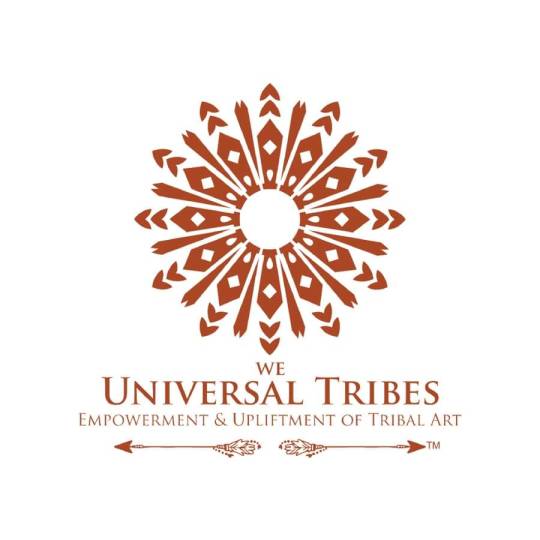
Universal Tribes is an organization which help the tribal people grow by selling their handmade and organic products by use of social media,promotional activities etc.The headquarters is in Pune India.There are wide rage of collection such as organic food,Ayurveda collection,Dhokha art,Bindu art,Warli paintings,Traditional naga jewelry,Gond paintings etc.We conduct many contests and camps for the people who want to experience the tribal lifestyle.
0 notes
Photo
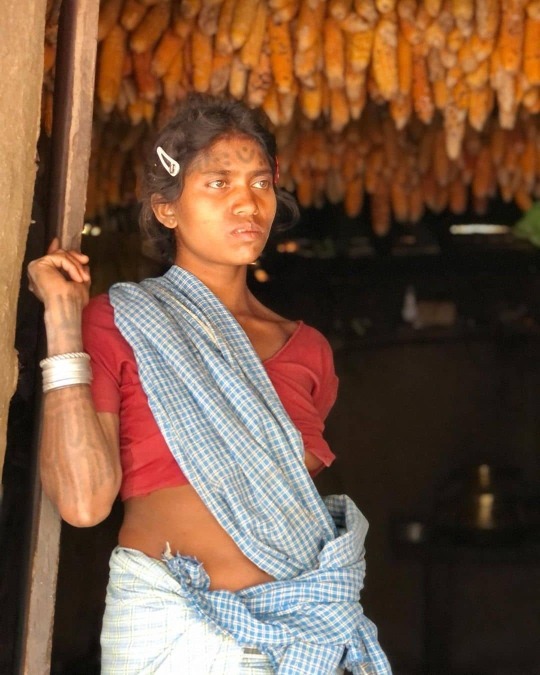
Captivating Chattisgadh! This beautiful state had been on our radar for many years. It was finally this month that we managed to do a road trip through some parts of this lesser explored gem. Many of us have only known Chattisgadh for its mining industry, tribals & the local socio- political issues. However, driving through this land for nearly a fortnight has been gratifying & eye opening to say the least. To do justice to the places and people we met - I’m aiming at making a theme wise series, called ‘Post cards from Chattisgadh!’ This is the first of the lot named ‘Tribes & their unique traditions’ Featured in these pictures are the Baigas- who’s lives personify contentment in simplicity. Their women have body tattoos( including their foreheads & chests) and some of the other tribes are the Dhurvaa, Dandamimaraiya, Gond & Muria. Some of the Baiga villages we visited are mainly farming communities who live off their land and have an annual income of 5 to 8 thousand rupees. Just puts our lifestyle into perspective!! A peculiar tradition followed by the Dhurvaa traibals after the passage of a person; is building a tomb stone/ plaque that has paintings of everything he/she liked doing. On top of the plaque are birds and branches which are meant to welcome the soul to come and perch on so as to oversee & protect their living family members! . . @indrajitlatey Exploring with: @manjirilatey . . #cfor36garh #chhattisgarh #incredibleindia #bastar #tribalsofindia #baiga #gond #earthwisepune #tribaltraditions #chhattisgarhtourism #chhattisgarhdaires #instatourism #instachhattisgarh #tourism #dekhoapnadesh #incredibleindia #tourist #instatravel #travelphotography #baiga #dhurva #tribe #kawardha #tribalstate https://www.instagram.com/p/CWxotGCP2Ko/?utm_medium=tumblr
#cfor36garh#chhattisgarh#incredibleindia#bastar#tribalsofindia#baiga#gond#earthwisepune#tribaltraditions#chhattisgarhtourism#chhattisgarhdaires#instatourism#instachhattisgarh#tourism#dekhoapnadesh#tourist#instatravel#travelphotography#dhurva#tribe#kawardha#tribalstate
0 notes
Photo
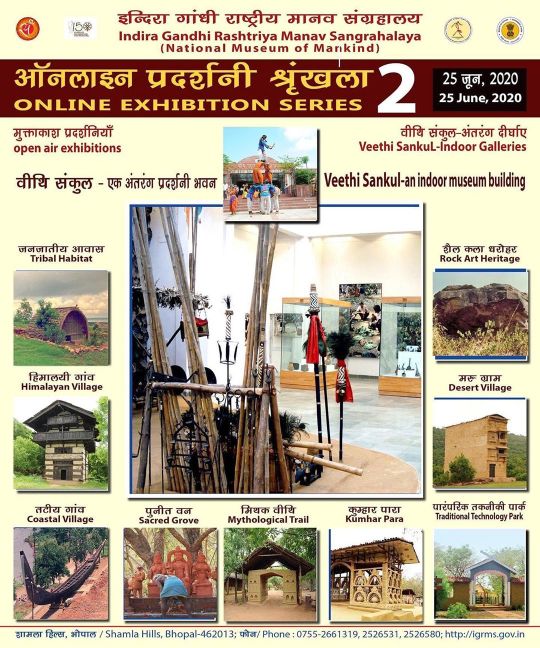
Indira Gandhi Rashtriya Manav Sangrahalaya (IGRMS) launched new series to display online the exhibits on its 200 acre campus in Bhopal with the aim of digitally connecting everyone with them due to lock-down during the current COVID-19 epidemic. The main objective of this series is to highlight the aesthetic features of traditional lifestyles, local knowledge and culture’s continuing relevance with modern society. Under this series, today indoor gallery no. 3 of the Veethi Sankul has been presented online with its basic information and photographs and videos. The Veethi Sankul is indoor museum buildings of this museum. There are 12 galleries in Veethi Sankul depicting bio-cultural evolution and variations of humankind. Exhibition displayed here showcase mainly different phases of prehistoric and contemporary life and culture of humankind, marital activities, variety of ornaments, folk and tribal musical instruments, performing arts, masks, religious and spiritual activities as also objects from cultures of North East. This video presentation is based on the exhibition “Lingo Yatra: A festival of Koitors” mounted at gallery no. 3 of Veethi Sankul. It gives a glimpse of philosophy of Gond, a major tribal group of India and its sub groups. A major portion of the exhibition covers Koitor Yatra / Lingo Yatra festival celebrated in the Bastar and adjoining districts of Chhattisgarh state. These larger groups of Gond tribe call themselves “Koitor” organize Jatra festival time to time for their socio-cultural integration. Lingo Jatra is based on the “Pen Karista” - an ancient traditional festival of these tribal groups. Material form of “Anga Deo” is also displayed in the exhibition. It is made of 3 equal size wooden planks. The central portion is called ‘koko’ which resembles face of a snake or a bird. Exhibition also depicts Ghotul – a social institution of Muria tribe as also their beautifully engraved combs, baskets, lamps, engraved gourds, ornaments, wood craft, paintings, images of gods and goddesses etc. Visitors can see this exhibition from home through the Official site (https://igrms.com/wordpress/?page_id=272) and Facebook site (www.facebook.com/onlineIGRM https://www.instagram.com/p/CB5AwwGDx7h/?igshid=yn2hvue20s3u
0 notes
Link
What’s Gond Art like today…
The descendants of the Gond Tribe have taken the art to paper and canvas today, making these beautiful vibrant paintings come into the limelight. Art connoisseurs from across the country buy these paintings and bring life to their art walls in their homes or on the walls of an art museum.
The elements of Gond Art Paintings still remain the same, with artists trying to cover the aspects of lifestyle of a typical Gond Tribal family. Today, Gond Art is recognized as one of the most popular and rather unusual forms of Tribal Art, making its way into Tribal handicrafts of India that have high artistic value.
#Gond Art: The Tribal Art From India#India#Gond Art#indian hanicrafts online#contemporary house decor items#contemporary house decor#tribal handicrafts#online handicraft store#handicraft items online#traditional handicrafts of india
0 notes